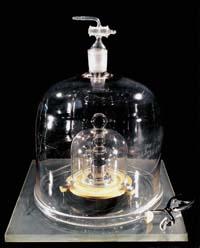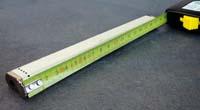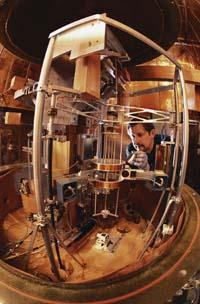Restoration of floor

However, recent mass comparisons do not say the same. In fact, there are several copies distributed throughout the world of the official kilogram that, sometimes, compare the official kilogram with its copies. When measured for the last time, Le Gran K lost 50 micrograms per the average mass of copies. That is, the official kilogram, instead of a kilo, weighs 999,99995 grams.
The definition of Kilogram of mass ups and downs makes little sense, is a problem to solve. And that's not why the shelf balance under the house does not measure well the weight of the apples we buy. The problem is deeper, since the definitions of certain physical and chemical magnitudes depend to a greater or lesser extent on mass, such as mol (atomic or molecular mass of a substance in grams) or newton (force expression unit expressed in kg.m.s -1).
Several groups of scientists have been looking for a new kilogram definition for years to definitively rule out these measurement errors. They have made many proposals, but above all they have strength two methods. For the moment, none of them have won this competition and will spend a few years to approve a new definition. The decision on what definition will represent the kilogram corresponds to the International Committee on Measures and Weights. They meet periodically to discuss the magnitudes defined and carry out the necessary modifications. They plan to choose the new definition of Kilogram for the year 2011. At the General Assembly.

Before with metro
It is not the first time that the international commission of measures and weights has had to redefine a magnitude. Like the kilogram, the meter was defined by an object until 1983. It was also a prototype in the form of an iridium platinum cane.
And like the kilogram, it had problems of size. The problem was solved at the International Conference of Measures and Weights of that year. The first work was to determine the speed of light, agreeing that the speed of light was 299.792.458 meters per second. Since then, when they were a totally defined magnitude, they found a definition that gave the metro an unalterable value: Distance from light to vacuum in 1/299.792.458 seconds.
That's what they want to do with the kilogram. The two proposals with greater force require a similar solution. As happened with the metro, they must necessarily determine certain constants that are not limited. In principle, constants have to have a specific value, that is why they are called constants, but sometimes, since they are magnitudes dependent on others, instead of having a certain value, they have a possible range of values.
One option indicates that the kilogram can be defined by specifying the number of Avogadro, and the other requires limiting the Planck constant in order to meet this goal. The first is known as the Avogadro project and the second as the Watt scale.
Determination of the number of Avogadro

The number of Avogadro is a fundamental constant of physics. It unites the macroscopic physical world with the submicroscopic world of atoms. Its definition is as follows: Number of atoms containing 12 grams of carbon isotope. This number is approximately 6,023 x 10 23, atoms found in 12 grams of carbon.
As can be seen, the number of Avogadro depends on the gram. This makes him depend on the variable prototype of the kilogram, that is, not being independent. The fact that the official kilogram has oscillations of 50 micrograms means approximately one trillion per atom!
The definitive fixation of the number of avogadro would allow to define the kilogram. To define it, scientists believe that the number of Avogadro must have these three characteristics. On the one hand, the value must be an integer because it represents a number of atoms. On the other hand, it must be a value within the range of values currently allowed. Finally, the number of Avogadro selected should be associated with a physical object; in short, the number of Avogadro indicates the number of atoms of an object.
When deciding what form the object has to have, there are several opinions among scientists. Some try to make a perfect silicon sphere of one kilogram and once realized they intend to count the number of atoms by X-rays. Others propose that the object has a geometric cube. Thus, it would be a cube with a certain number of atoms on each side, whose cube would give the value of the number of Avogadro.

Supporters of the object being a cube say that, being a sphere, it is much more difficult to relate the number of atoms to the volume of the object because the number is introduced to calculate the volume, so it would be impossible to give a very concrete value.
Regardless of the object, and considering that the number of Avogadro is the number of atoms of 12 grams of the 12 carbon isotopes, the kilogram would be defined by this method as: 1.000/12 x Number of Avogadro. Since the number of Avogadro is a limited value, there would be no risk of incident.
Use Watt scale
The other proposal of greater force for the redefinition of the kilogram is based on the so-called Balance of Watt. In short, through the Watt balance they determine the amount of electric current necessary to attenuate the weight of a mass of one kilogram. In fact, the electric current produces electromagnetic force, which is the one that exerts a force against the weight.
The mass of one kilogram is placed on the plate of a scale, surrounded by a coil of copper wire and a coil of superconductor material around the latter. The electromagnetic field necessary to combat the kilogram is generated by passing electricity through the coils. Based on certain physical properties and measuring the electric current and the voltage generated by the system, we can obtain the relationship between the mass placed in balance and the constant of Planck by some operations.

In fact, the use of a prototype of a kilogram may appear to be a contradiction in the definition of the kilogram, but by the time the force needed to deal with the weight of such a prototype is determined, the prototype would lose the importance it had until then and no longer have to be used.
Main problem, precision
It is not clear which of the two methods will choose. In any case, the accuracy of one and the other will be decisive. The most accurate when measuring it will be, probably, what will come to have an official definition.

In fact, the lack of precision presented by the current prototype has motivated the search for new kilogram definition pathways. Therefore, the magnitude to be replaced should be more accurate than the prototype. The uncertainty of the official prototype is 0.05 per million, and with other methods so far it has not been so accurate. For approval, the International Committee on Measures and Weights has stated that the error should not exceed 0.02 parts per million.
Although they have not yet achieved this, both those who bet on one method and those who bet on the other are convinced that they will be able to increase the accuracy of the measurements before it is late, and develop a method that can be presented at the international meeting of measures and weights.
With the election of the Commission, we will soon have a new definition of kilogram and the current thinned prototype will be commemorative of a museum. We do not know if when they define they will force all users of the scales to calibrate their devices. Surely not, and then it will be your decision to adapt the balance that has in hand to the new definition, or continue with the calibration made during the validity of the old prototype.

Buletina
Bidali zure helbide elektronikoa eta jaso asteroko buletina zure sarrera-ontzian











